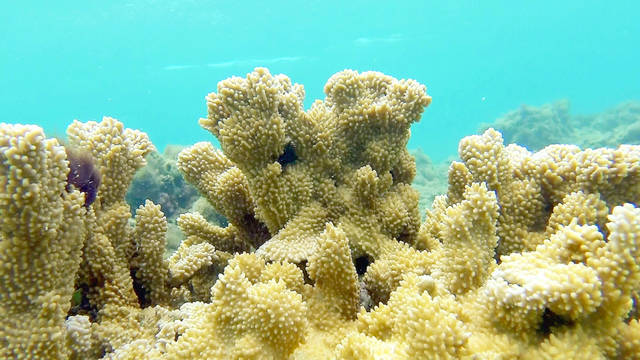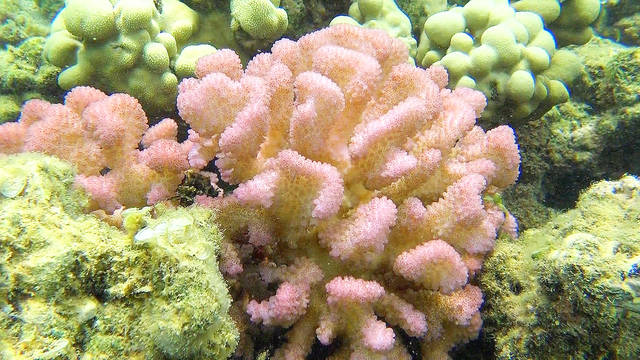ANINI — Under the surface of the shallow bay at Anini Beach, life is thriving.
Yellow antler corals, pink cauliflower corals, and purple lobe corals are all healthy in the area, and researchers say they’ve seen up to eight inches of coral growth there — and that’s just in 2017.
“I just did my bi-monthly survey at Anini and the corals were all disease free and continuing to grow at a rapid rate,” said Terry Lilley, who has been shooting underwater footage in the area for more than five years.
He continued: “An example is the yellow antler coral, white finger coral and brown rice coral, (which) all grew about eight inches in one year. This is so exciting as we all thought that corals grew, at best, a few inches a year.”
Harry Rabin, with ReefGuardians, said it’s not just the coral that’s thriving underwater, either.
“So many fish, too,” Rabin said, “It’s amazing.”
In 2014 and 2015, warming ocean temperatures were blamed for the world’s third bleaching event, according to the National Oceanic and Atmospheric Administration, and studies showed the event really hammered Hawaii’s corals.
Nearly 50 percent of Hanauma Bay Nature Preserve bleached, and bleaching was also observed on Maui and in areas of Oahu’s Kaneohe Bay, as well as on Kauai’s North Shore.
In 2017, the state Department of Land and Natural Resources
Division of Aquatic Resources developed a coral reef recovery plan in conjunction with NOAA, University of Hawaii and The Nature Conservancy.
Decreasing environmental stressors and bolstering coral population were some of the strategies for promoting coral recovery after the bleaching events. The documents outlines strategies like securing the substrate for coral larvae, protection of herbivores in the ecosystem and control of algal growth. In the lab, scientists have been working to find ways to improve the resilience of corals, and propositions run the gamut from transplanting and fertilizing corals to genetic engineering.
Between 2008 and 2013, Lilley shot more than 300 hours of underwater footage of Kauai’s North Shore coral reefs, and “they were fairly healthy,” but between 2014 and 2015, more than 70 percent of them died, he said. But they’re bouncing back, and not just at Anini.
“From late 2015 to now, the corals are growing back at an abnormal rate,” he said. “We are also having an explosion of baby fish, especially the butterfly fish. Since they eat coral, it is a real positive sign.”
New blankets of coral cover the substrate at Milolii and Nualolo, and also at Makua (Tunnels).
Other theories out of the scientific community for the diseased coral include excess nutrients and pharmaceutical drugs, sediments and sunscreens in the water, as well physical human impacts like seawalls and people walking on the reefs.
“There are a few small patches (of blue rice coral) growing back at Waipa and Tunnels, but not much anywhere else,” Lilley said. “(But) I have documented this new coral growth at over 30 different dive sites. All good news!”




“In the lab, scientists have been working to find ways to improve the resilience of corals, and propositions run the gamut from transplanting and fertilizing corals to genetic engineering.”
Oh, NO!!! Genetic Engineering!! What a travesty! We can’t let these mad scientists ruin our organic ocean!!! Next they’ll want to douse the corals with pesticides!!
I care about the fisheries too. After seeing the pearl harbor once and Waikiki Aquarium, it makes me feel like there is another paradise in Hawai’i. I haven’t bought any videos, but ABC stores or B & N bookstores may have some. It is always on display. I saw some books on it already. I suppose. My cousin, second cousin died at Anini beach while spear fishing there in the 1980. He was a junior at Waimea high school. The waters there are real shallow. Knee high and up to 150 yards out from the shoreline. Drowning. Nobody was sure what happened. He played for the Waimea high school varsity team basketball. He looked pretty hot touching the back boards while laying up at the basketball games. He lost all of his glory, when he died in Aninini beach, in 1980. Just sad that Anini has strong currents and nobody knew about it then to tell him. That is my story at Anini.
Terry Lilley is NOT a marine biologist, please stop quoting him as if he is. Just because a person does a bunch of underwater videos and ‘surveys’ does not make them a credible source of information. Please please use a valid source and actual scientist to quote in future articles about marine issues. Thank you!
Sarah Schmidt, you need to check your facts before slandering Terry Lilley.